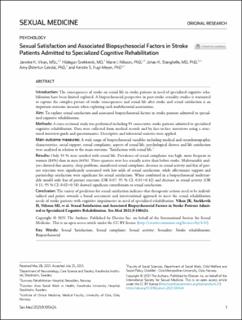| dc.contributor.author | Vikan, Jannike | |
| dc.contributor.author | Snekkevik, Hildegun | |
| dc.contributor.author | Nilsson, Marie I. | |
| dc.contributor.author | Stanghelle, Johan K. | |
| dc.contributor.author | Geirdal, Amy Østertun | |
| dc.contributor.author | Fugl-Meyer, Kerstin S. | |
| dc.date.accessioned | 2022-03-28T13:58:41Z | |
| dc.date.available | 2022-03-28T13:58:41Z | |
| dc.date.created | 2021-12-10T15:07:23Z | |
| dc.date.issued | 2021-08-30 | |
| dc.identifier.citation | Sexual Medicine - Open Access. 2021, 9 (5), . | en_US |
| dc.identifier.issn | 2050-1161 | |
| dc.identifier.uri | https://hdl.handle.net/11250/2988099 | |
| dc.description.abstract | Introduction: The consequences of stroke on sexual life in stroke patients in need of specialized cognitive rehabilitation have been limited explored. A biopsychosocial perspective in post-stroke sexuality studies is warranted to capture the complex picture of stroke consequences and sexual life after stroke and sexual satisfaction is an important outcome measure when exploring such multifactorial associations.
Aim: To explore sexual satisfaction and associated biopsychosocial factors in stroke patients admitted to specialized cognitive rehabilitation.
Methods: A cross-sectional study was performed including 91 consecutive stroke patients admitted to specialized cognitive rehabilitation. Data were collected from medical records and by face-to-face interviews using a structured interview guide and questionnaires. Descriptive and inferential statistics were applied.
Main outcome measures: A wide range of biopsychosocial variables including medical and sociodemographic characteristics, social support, sexual complaints, aspects of sexual life, psychological distress and life satisfaction were analyzed in relation to the main outcome “Satisfaction with sexual life.”
Results: Only 33 % were satisfied with sexual life. Prevalence of sexual complaints was high, more frequent in women (84%) than in men (64%). Three-quarters were less sexually active than before stroke. Multivariable analyses showed that anxiety, sleep problems, manifested sexual complaint, decrease in sexual activity and fear of partner rejection were significantly associated with low odds of sexual satisfaction, while affectionate support and partnership satisfaction were significant for sexual satisfaction. When combined in a biopsychosocial multivariable model only fear of partner rejection (OR 0.07; 95 % CI: 0.01−0.42) and decrease in sexual activity (OR 0.11; 95 % CI: 0.02−0.58) showed significant contribution to sexual satisfaction.
Conclusion: The variety of predictors for sexual satisfaction indicates that therapeutic actions need to be individualized and points towards a broad assessment and interventional approach to meet the sexual rehabilitation needs of stroke patients with cognitive impairments in need of specialized rehabilitation. | en_US |
| dc.description.sponsorship | This work was supported by The South-Eastern Norway Regional Health Authority (Helse Sør-Øst). | en_US |
| dc.language.iso | eng | en_US |
| dc.publisher | Elsevier | en_US |
| dc.relation.ispartofseries | Sexual Medicine;Volume 9, Issue 5, 100424 | |
| dc.rights | Navngivelse 4.0 Internasjonal | * |
| dc.rights.uri | http://creativecommons.org/licenses/by/4.0/deed.no | * |
| dc.subject | Sexual satisfaction | en_US |
| dc.subject | Sexual complaints | en_US |
| dc.subject | Sexual activity | en_US |
| dc.subject | Sexuality | en_US |
| dc.subject | Stroke rehabilitation | en_US |
| dc.subject | Biopsychosocial factors | en_US |
| dc.title | Sexual Satisfaction and Associated Biopsychosocial Factors in Stroke Patients Admitted to Specialized Cognitive Rehabilitation | en_US |
| dc.type | Peer reviewed | en_US |
| dc.type | Journal article | en_US |
| dc.description.version | publishedVersion | en_US |
| dc.rights.holder | © 2021 The Authors | en_US |
| dc.source.articlenumber | 100424 | en_US |
| cristin.ispublished | true | |
| cristin.fulltext | original | |
| cristin.qualitycode | 1 | |
| dc.identifier.doi | https://doi.org/10.1016/j.esxm.2021.100424 | |
| dc.identifier.cristin | 1967179 | |
| dc.source.journal | Sexual Medicine | en_US |
| dc.source.volume | 9 | en_US |
| dc.source.issue | 5 | en_US |
| dc.source.pagenumber | 1-14 | en_US |

